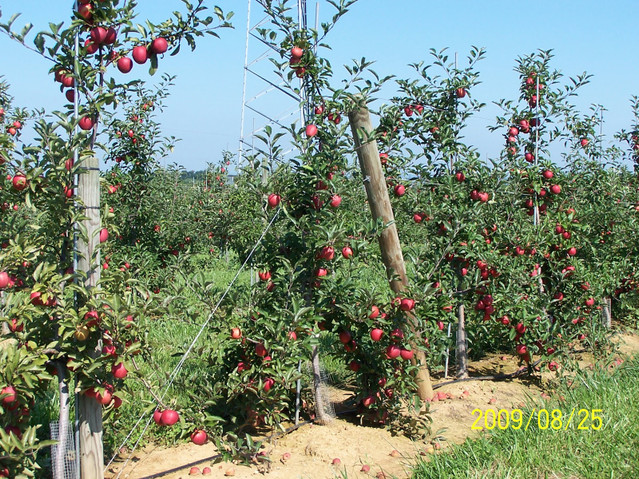Posted by Kauffmans Fruit Farm on 16th Jan 2019
Habits of Growth and Productivity
From Clair Kauffman’s Journal (1/12/18) - Orchard Manager
Photos: Kauffman’s Orchards
Winter in the orchard is a time for the fruit farmer to observe tree growth from the previous season. The icy winter chill has chased much of the trees’ vitality into the hidden root zone, leaving naked and leafless trees. To an untrained eye, all that’s left is a wall of boring, drab-colored branches.
But even in a state of dormancy, the trees I care for are telling me something by their now obvious branch structure and the past season’s growth. Pause with me, and listen to their quiet story.
Recently, I pruned our 3 year old Nittany apple trees. In 2017, they were probably the fastest growing trees in the orchard and have a plethora of upright, fast-growing branches. While it’s exciting to see such robust growth, it’s kind of like untempered youthful ambition. Ideally, the vertical central leader (main trunk) grows quickly to a mature height forming an axis and structure for the horizontal, slower-growing, fruit-bearing branches. In fruit trees, this physiological disposition of vertical branches to grow faster and stronger is known as “apical dominance.” A branch with apical dominance generally has less or little reproductive physiology. A tree that has multiple leaders clamoring to dominate the apex, a lot of vertical growth, and sparse horizontal branching can become a fruit farmer’s nightmare. It can quickly overgrow it’s space in the orchard; fail to form ample fruit buds; make for extra pruning labor; rob light, water and nutrients from fruit-bearing branches; and trade precious productivity for showy vegetation. The orchard version of kitchen wisdom should be something like “Too many central leaders spoil the apple tree.” In contrast, trees whose secondary branches grow off the vertical axis at a more horizontal orientation induce the formation of fruit buds and become quite productive with higher quality fruit. The branches grow much more slowly and provide ample opportunity for the annual pruning to maintain ideal branch structure.
So these young Nittany trees are presenting a bit of a problem. But don’t get me wrong. I love Nittany apples and even ate one yesterday after a quick stroll through cold storage. It had superb flavor, to say the least. The trees are still young and I think the trees can be guided in the right direction. It’s going to take some severe and painful pruning, though, and we’ll head back out later to literally bend some of the remaining branches down to a more desirable orientation.
In all this lies a tremendous metaphor. Personal growth and productivity can take many forms, but the most fruitful change a person can undergo is slow and humbling work. And it is hard, very hard. Much of it can never really be told. All who walk this path discover a strong inner resistance to growth of this nature -- the humble and painful bowing of the head on a slow and unnoticed path of descent to greatness, to become what was intended for humans to be. Nevertheless, pure and life-giving fruit begins to emerge as we desert the fast track to personal growth, embrace the unseen, give up our efforts to ascend and dominate the apex, and let go of the illusion that our super-egos claim as true -- that we are the sum of what people think we are. If that wizened elder is patient, know that it was learned through the devastating failures of impatience. If they are loving, it was born of first-hand experience with hatred and contempt. If they are truly gentle, they once suffered the consequence of their own or others’ unrelenting harshness. If they are humble, they know the loneliness and emptiness of arrogance. Wisdom from the prophet Isaiah says that strength comes from quietness and trust, salvation from repentance and rest. Jesus of Nazareth said that the greatest is the humbled, the one who serves.
To some, I’m in the “prime of life,” an expression that implies that usefulness and fruitfulness is getting smart and noticeable things done. In reality, we rarely get to experience any significant overlap of energy and wisdom. Like those silly Nittany trees, I resist the true path to fruitfulness and greatness, frantically grasping for the endless metrics of success. In the winters and wildernesses of life, with the “leaves” no longer hiding my little known insecurities, false starts, and failures, I am invited to humbly flex to the hiddenness of slow and internal transformation, to be honest about the actual fruits of my life, and to accept the counter-intuitive path to fruitfulness. I am called to a vital connection to Christ, the central branch, the central leader - the ultimate servant who repeatedly taught and modeled true, live-giving greatness.

